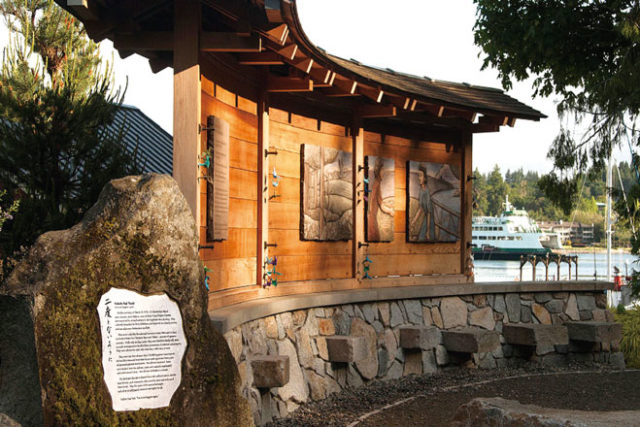
By Clarence Moriwaki
On March 30, 2002, more than 700 people gathered at the foot of Taylor Road on Bainbridge Island, the site where 60 years ago at the former Eagledale Ferry Dock, 227 Bainbridge Island men, women and children of Japanese ancestry – two-thirds of them American citizens – were gathered by U.S. Army soldiers and boarded a ferry to Seattle to become the first forced removal and exclusion of 120,000 Japanese Americans from the West Coast of the United States during World War II.
The 90-minute ceremony featured Gov. Gary Locke, U.S. Rep. Jay Inslee, local officials, multi-faith leaders and inspiring music to honor this historic event and the supportive community that welcomed them home.
There were great speeches, blessings and music, and when the reading got underway of the names of all of the 276 Japanese Americans on Bainbridge Island at the start of World War II, crows began to fly into the alder trees that lined both sides of Taylor Road.
At first there were just scattered cries of “caw,” but as the list of names continued, more and more crows filled the trees, along with a growing cacophony of “CAW, CAW, CAW, CAW!!” The chorus of crows became so deafening that many people could not hear some of the names being read.
The crows showed no sign of abating, and the crowd was holding its collective breath as the list grew near the end, since following the reading of the names on the program was a reflective Moment of Silence.
When the final name was read, as if a switch was flipped to “off,” the din from the caws from the crows immediately stopped. After the Moment of Silence was over and I thanked the crowd, all of the crows all began to fly away.
At the end of the ceremony, a Squamish tribal elder came up to me and said, “Clarence, that was so amazing about the crows.”
“Yeah, their timing was impeccable,” I replied.
“No, you don’t understand, we native peoples believe that blackbirds are the spirits of our ancestors.”
My hair stood up on the back of my neck. I could not recall any other time during the 90-minute ceremony when the crows were cawing, nor could any other person present.
I was able to get the raw video tape from our videographer as well as the tapes from the TV stations present, and we put together the entire ceremony. We listened to the VHS tape many times, and the only time we can detect a single crow’s caw is during the reading of the names.
Even today, when I’m at the Memorial site and sharing this story to tours and guests, a crow – or crows – will caw. I often say, “I wonder who’s stopping by and saying hi.”






